Outsourcing, whether it’s dedicated teams or staff augmentation becomes a popular alternative in software development. Nevertheless, regardless of service-cost efficiency, leading a remote team might cause some challenges. Unclear goal setting and role distribution, weak communication can disempower the team, leading to employee burnout.
With its in-depth 15 years of experience, Agilie handles it through building an empathetic, open-minded corporate culture, integrating retrospectives and clear feedback to stimulate cross-functional collaboration. In this article, we present 8 tips on how to manage a remote development team effectively.
Why Managing Remote Teams Requires a Different Approach
When it comes to managing remote development teams, you might encounter complications in communication, motivation followed by the range of risks, including the lack of visibility & accountability, security & technology obstacles, etc. Coverage of these hurdles requires a different approach to team management as lack of timely response might lead to drastic outcomes.
Communication Challenges
The communication challenges arise as a result of time zone differences. This factor complicates the overall remote team’s report of the deliverables, leading to the potential delays in the software production. The reasoning behind is the complications in addressing urgent cases, which requires a direct interaction with the product owner or business representative on the client’s side.
Although enterprises and startups craft personalized communication plans that touch upon the communication of the extreme cases, the risks of delayed response and so production delays remain.
Motivation Setbacks
Working from home, especially for the foreign IT outsourced specialists might be burdensome as due to the lack of direct communication, team interactions, or self-development possibilities.
Micromanagement and extensive control might discourage your team, leading to burnout, minimized efficiency, and a lack of commitment. Trusting team members to manage their own tasks can create a sense of employee ownership over their progress and recognition, leading to improved responsibility.
Routine working cycles undermine out-of-the-box thinking, devaluing the workers’ contribution and leading to dissatisfaction. Integrate educational resources, conduct online courses, webinars, and quizzes, to stimulate the remote team’s interest and increase commitment.
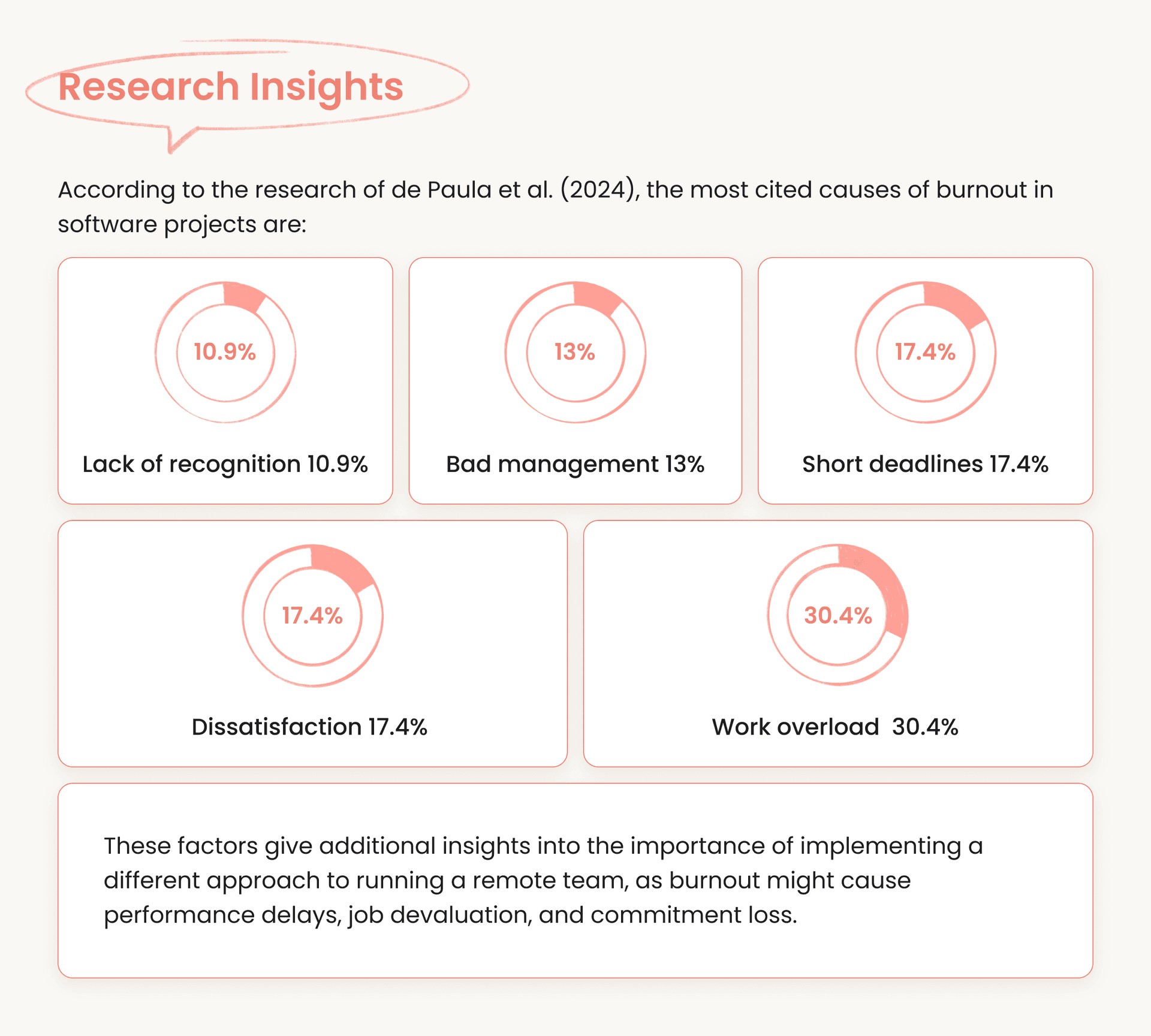
Source: Zenodo
Risks
-
Lack of Trust & Accountability
Managers can experience complexities with tracking productivity as operating a remote team lacks direct oversight. This can lead to a lack of trust, micromanagement, and misunderstanding, and create a poor professional environment, leaving employees directionless.
-
Security & Technology Challenges
While working from home, remote employees rely heavily on personal devices, which increases their vulnerability to cyberattacks and data breaches. Load shedding might affect productivity and Internet connectivity, slowing down performance.
Tip #1: Hire for Skills and Remote Mindset
Business representatives tend to implement a result-oriented approach when hiring a remote IT team. So, undoubtedly, determining the core hard skills will be the backbone of the technical correctness of your bespoke projects.
Hard Skills - The Pillars of Your Project
Hard skills refer to the team’s technical capabilities and proficiency required to craft a sophisticated, functional, and secure application. Here are the top hard skills necessary for any software project.
-
Programming Languages
Proficiency in programming languages (Solidity, Python, C#, Java, etc.) is fundamental to software development, as the team can craft the instructions the computers will perform, and make the code reusable based on languages’ modules, features, and classes.
-
Cloud Computing
Knowledge of AWS, Azure, or Google Cloud to scale the resources per project needs, as well as accelerate project deployment with the help of pre-configured environments.
-
Databases
Competency in NoSQL databases like MongoDB and SQL alternatives such as PostgreSQL or MySQL, as well as the concepts of querying, data modeling, etc., will be paramount to maintaining scalable and reliable data storage.
-
Web Development
Expertise in HTML, CSS, JavaScript, and frameworks like React or Angular will be central in building a practical and intuitive web application, regardless of the business niche.
-
API
Skillfulness in RESTful APIs assists developers in setting communication and interaction between the system’s components.
-
Testing & Debugging
Mastery of testing frameworks is paramount to web browser testing (end-to-end Cypress) and automating web browser testing (Selenium).
 Explore how to hire developers for the fintech industry.
Explore how to hire developers for the fintech industry.
Soft Skills - The Fuel of Progress
While hard skills are the backbone of the software project, soft skills are the catalyst for advancement. Here is the list of soft skills you should consider when hiring a remote development team.
-
Problem-Solving
The employees’ ability to reach a unique solution by breaking the extensive problem into small clusters is a driving force in shaping a high-caliber digital product.
-
Asynchronous Cooperation
Access to the same documentation, task prioritization, defined expectations, and clear goals can lead to asynchronous communication which glides the challenge of time zone differences.
-
Critical Thinking
Strategic informational analysis, problem decomposition, the ability to detect potential errors prior to their emergence, and implementing the corresponding preventive strategies can reduce errors and boost the project’s performance.
-
Adaptability
The ability to integrate brand-new technologies, as well as switching between tasks, help remote employees keep track of project priorities, minimizing the progress delays.
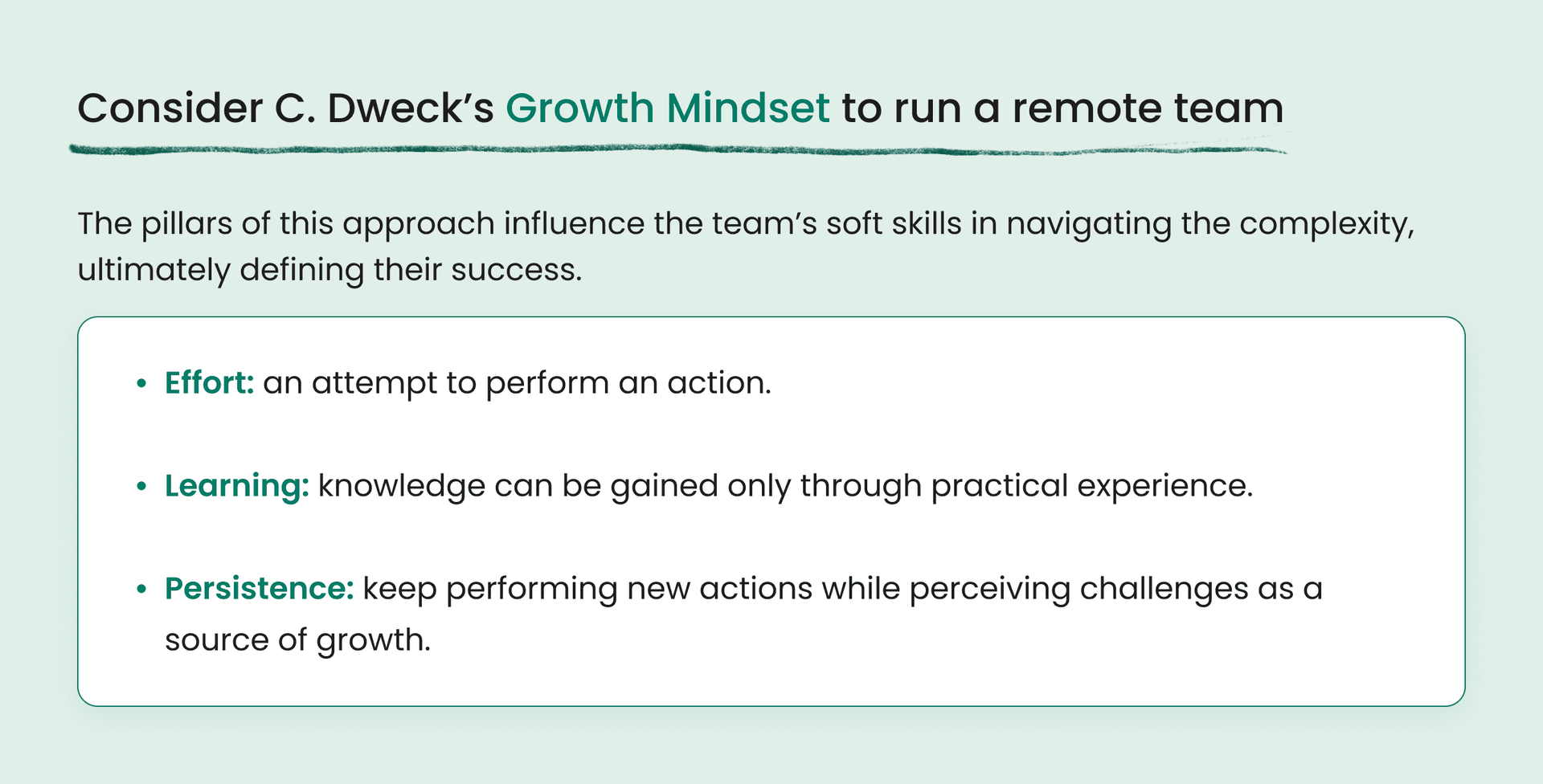
Source: National Association of Workforce Development Professionals.
Tip #2: Set Clear Expectations and Define Goals
The importance of clear goal, roles, and deadline definition is unquestionable, as if set objectively, managing remote development teams can experience a decrease in ambiguity and increase in the sense of commitment, cooperation, and motivation. Consequently, you can enjoy a high-grade solution.
Clear Goals
Don’t forget that a clear and straightforward goal determines the product development direction.
-
Common Understanding
Remote team communication lacks desk-side conversation, complicating mutual understanding of the same tasks and projections. Clear communication, recorded video meetings, PowerPoint presentations, and short PDF précis can contribute to shared understanding and reduce ambiguity. Each team member feels valued, which boosts their accountability for the quality of the project outcomes.
-
Enhanced Motivation
Straightforward goals present an underpinning - a reason behind the peculiar objective. When the remote team understands ‘why’ the members are performing a specific project action, they experience increase in motivation based on understanding of the purpose and value of their contribution.
-
Measurable Outcomes
The clarity of goals depend on their measurability, enabling you to track the progress and determine strengths, weaknesses, obstacles, and overall status of goal achievement. DORA metrics (Deployment Frequency, Lead Time, Mean Time to Restore, Change Failure Rate), agile retrospectives, etc., can be involved to measure outcomes.
Result assessment is one of the core factors on how to manage a remote development team effectively, as employees appreciate the value of time, which reduces the procrastination level.
Defining Roles
Defining roles is central in decoding core responsibilities, task complexities, and overall workload, leading to balanced inter-team collaboration.
-
Avoiding Ambiguity
Clear role definition prevents task & role duplication, so that each employee can focus on their specific tasks. This minimizes ambiguity when the employees can unintentionally performs the same action, and avoids time waste as a result.
-
Streamlined Expertise
When the roles and tasks are defined based on the developer’s level of expertise, it implies that each person is in the right place, which can reduce time overspending and prevent deadline delays as the roles defined based on the competency level determine the level of load and skills required for solving the problems.
-
Conflict Prevention
Clear role definition can enable you to prevent conflicts on responsibilities and avoid overworking, as each team member will focus only on their specific assignments, leading to a more proactive and collaborative environment.
Setting Deadlines
Clearly defined deadlines can help optimize performance by prioritizing obligations and providing remote workers with opportunities to cultivate & improve their time management skills.
-
Time Management
Again, deadlines represent an efficient approach to reduce procrastination and set task priorities, enhancing the remote team’s self-discipline.
-
Optimized Project Flow
Set deadlines creates the structure of task hierarchy, where the employees from different time zones can work in a timely manner to minimize delays. Deadlines boost responsibility, especially for the async inter-team cooperation, bypassing project interruption.
-
Intertwined Dependency
Tasks are interdependent, so setting deadlines can help prevent bottlenecks for the downstream tasks, improving members’ time management skills.
Tip #3: Use the Right Collaboration Stack
An efficient management of a remote development professionals require you to integrate team collaboration tools to manage communication, track project progress, and analyze the development process.
Communication Tools
Communication tools can help you set your inter-team communication integration to deliver the agenda and essential project management details.
-
Slack: a multidimensional platform, enabling the members to send real-time messages, communicate via video huddles, and operate versatile tools to configure versatile integrations (e.g., PeopleForce for HR management).
-
Microsoft Teams: Interlinked to the corporate accounts, Microsoft Teams provides an instantaneous video communication, enabling users to record the video and share materials on-screen.
Project Management Tools
Project tracking software enables you to analyze performance progress and determine the time employees take to perform specific tasks. These tools enable you to track the complexities and areas of improvement in the workers’ goal accomplishment.
-
Trello: applying the Kanban boards, Trello is an efficient visual task management tool, which is perfect for visualizing the workflow.
-
Jira: Jira focuses on agile project management features, enabling clients to decompose tasks into different statuses, convenient for time tracking per task performance.
Code Management Tools
Code management tools are essential to monitor code evolution and support teamwork among developers.
-
GitHub: is an indispensable platform for developers to promote effective version control and public code management.
-
Bitbucket: a GitHub alternative, Bitbucket focuses on private code management and version control, pertaining to businesses leveraging Atlassian solutions.
Time Tracking Tools
Time tracking tools correlate with the project management stack as they can be integrated into the workflow management systems.
-
Harvest: Simple one-click time logger available for web browsers, Mac, PC, and mobile OS, which gets the team notified based on the daily reminders.
-
Sloneek: A Harvest alternative, Sloneek is a time tracker application included in all-in-one HRMSs. It grants precise time management compatible with Jira.
Tip #4: Communicate with Intention: Sync & Async
How to manage remote developers on your team effectively and proactively? Reconsider your communication approaches and channels of agenda delivery. Bring the value of synchronous and asynchronous communication.
Synchronous Communication
Synchronous communication refers to the real-time interaction, where the presence of each team member is a must. For instance, a retrospective meeting in Microsoft Teams. The participants gain instantaneous feedback and obtain a sense of commitment and live interaction. Synchronous communication is perfect for discussing challenges, deadline setting, to getting the team and team-lead notified on the progress.
Asynchronous Communication
On the contrary, you can switch to asynchronous communication when the immediate feedback is not crucial. For instance, Remote team members based in diverse locations can send messages via Slack or write comments in Jira, reflecting iterative and cyclic project development.
Sync & Async Communication: Impact on Performance
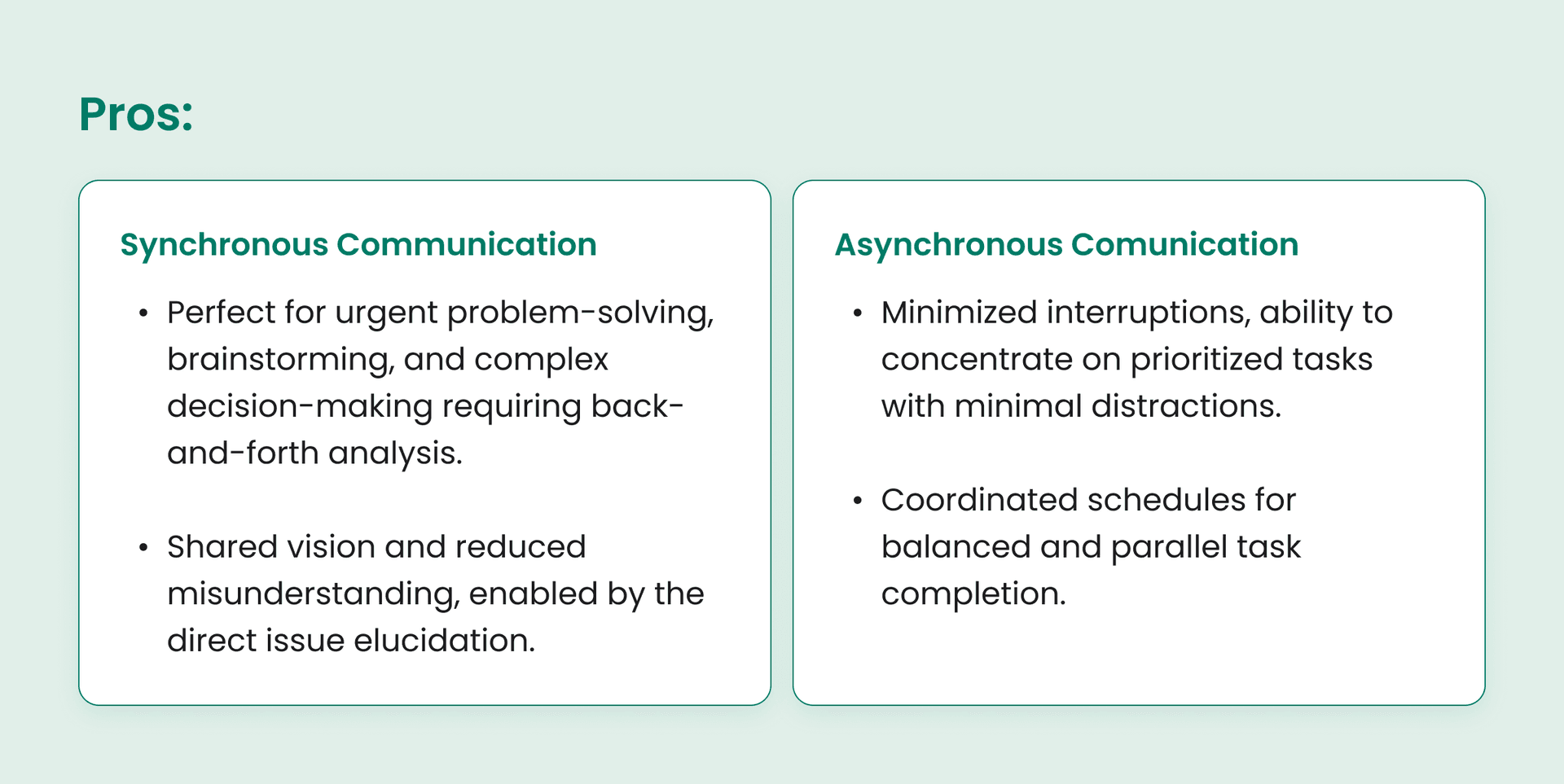
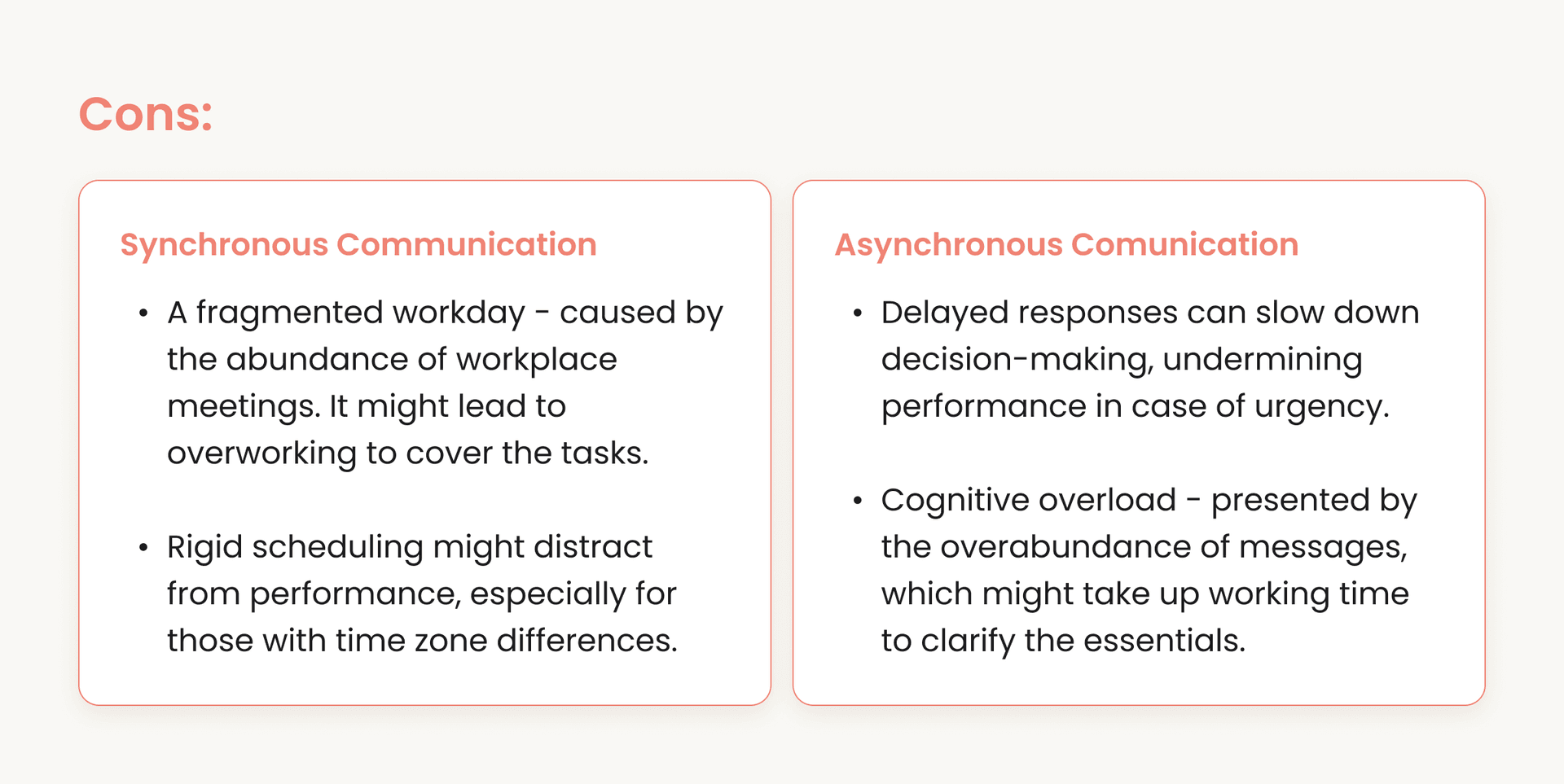
Tip #5: Create a Remote-First Culture
Managing remote development team requires establishing a smooth and proactive distributed team culture. Well, crafting a remote-first environment will cover the aforementioned factors on communication, stack, and goal definition. But we’ll sprinkle them up with a zest of sophisticated add-ons.
-
Balance sync and async communication. You don’t have to concentrate on the daily video calls, add some message-only days, where the employees will mainly focus on their tasks, while they’ll be able to report on the progress in messages.
-
Build a robust project management infrastructure. Invest in project management tools, time trackers, communication software, and the other stack relevant to your project development methodology (Agile, Kanban) to streamline human and time resource management.
-
Focus on hiring a remote & growth mindset. Look for candidates who not only express in-depth hard skill competency but who demonstrate excellence in self-organization skills, time management, and who show interest in growth opportunities through challenges.
-
Set a clear remote developer onboarding process. Provide workers with access to required documentation, project management/communication tools, and clarify corporate-level time management strategies.
-
Provide regular feedback. Perform regular one-to-one meetings, conduct anonymous questionnaires to assess the performance of each team member, detect strengths and areas for improvement.
 Find out how to hire a development team to build a neobank.
Find out how to hire a development team to build a neobank.
Tip #6: Monitor Performance Without Micromanaging
Assessing performance might be challenging as micromanagement leads to employee burnout and dissatisfaction. Why not try the alternatives?
SMART Goals
This performance management approach comes along with a clear goal definition, yet it narrows it down till it can be measured.
Set individual outcome-oriented goals, which should be:
-
Specific: to determine what exactly the member has to achieve.
-
Measurable: to clarify how you will know about the goal's completion.
-
Achievable: to underline whether the goal is realistic in terms of the available time and resources.
-
Relevant: to denote whether the goal completion aligns with the institution’s objectives.
-
Time-driven: to consider what deadline the goal needs to be achieved within.
DORA Metrics
This measurement procedure refers to checking the efficiency of the delivery pipeline. It does not relate to the employee’s direct performance but indicates a step-by-step assessment of the outcomes.
Deployment Frequency: aims to answer the team’s frequency of successful production, as the higher the number, the smaller risks.
Lead Time for Alterations: refers to the period between the code commitment and its production. A shorter lead time indicates faster delivery.
Change Failure Rate: clarifies the percentage of deployments that end up in a failure. The high product quality relates to the low failure rate.
Time to Restore Service: indicates how much time is required to recover from the failure. Product resilience is characterized by a lower recovery time.
Tip #7: Run Regular Retrospectives
Although remote teams offer flexibility and professional adaptability, the communication gap is undeniable. Why not integrate retrospective meetings? Select one day during the week and conduct a retro - an assessment of the employee’s weekly performance.
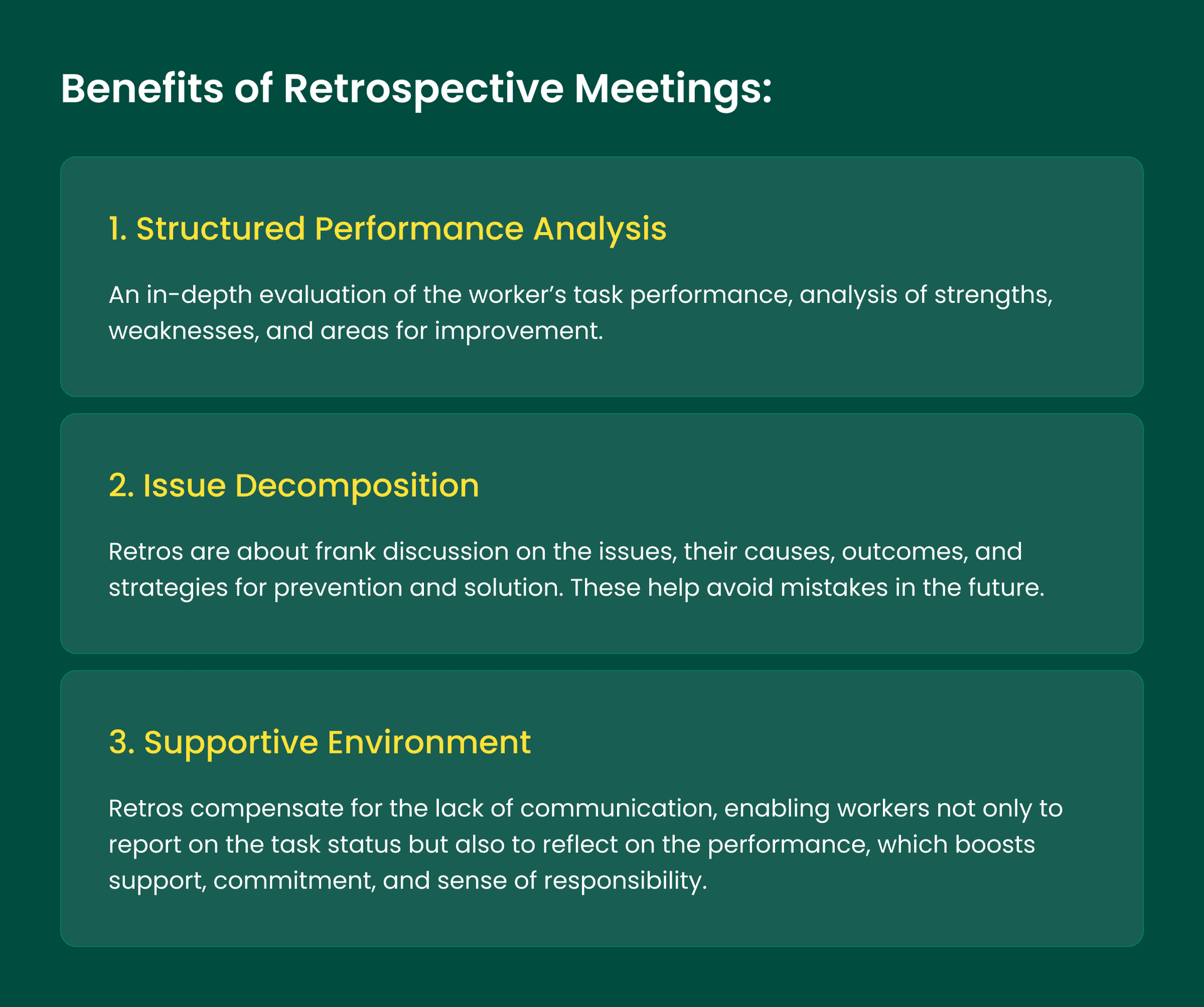
Tip #8: Encourage Feedback & Recognition
Feedback & recognition are the core elements to bring transparency and build a trustworthy relationship between the leader and the employee.
Regular Feedback and Justified Recognition promote:
-
Improved Accountability: based on the justified praise and clear feedback, the employee understands the direction, which is helpful to determine priorities and responsibilities for their tasks.
-
Problem-solving: praise and feedback promote both leader-member problem-solving and the employee’s personalized search for solutions. In the latter, the team lead plays the role of the objective observer who gives recommendations, while the worker cultivates indispensable solutions.
-
Trustworthy Relationship: remote workers can feel supported throughout an objective performance assessment. This leads to detecting areas of personal growth, showing commitment and loyalty to the organization.
Summary
Managing a remote team requires paying attention to the employees’ professional skills, yet not excluding their human needs. Recognizing talents, building a trustworthy environment, and integrating retrospectives and feedback can balance the load, make workers feel supported, and prevent burnout. Balancing life and work through clear roles, objectives, and deadline definition can enhance remote developers' accountability, loyalty, and sense of commitment.
 Interested in hiring a remote development team? We’re excited to help you on your software journey!
Interested in hiring a remote development team? We’re excited to help you on your software journey!
